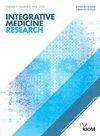Effect of electroacupuncture versus prucalopride for ultra-severe chronic constipation: Secondary analysis of a randomized controlled trial
IF 3
4区 医学
Q2 INTEGRATIVE & COMPLEMENTARY MEDICINE
引用次数: 0
Abstract
Background
To explore the effect and safety of electroacupuncture (EA) compared to prucalopride in patients with ultra-severe chronic constipation (USCC), a condition defined by the absence of weekly complete spontaneous bowel movements (CSBMs).
Methods
This study was a secondary analysis using data from a multicenter, non-inferiority randomized controlled trial, involving patients with USCC. Participants received either EA or prucalopride treatment. The primary outcome was the mean weekly CSBMs from weeks 1 to 8. Secondary outcomes included the mean weekly CSBMs, the proportion of overall and weekly responders, changes in straining and stool consistency scores, Patient Assessment of Constipation Quality of Life (PAC-QOL) scores, and the proportion of patients using rescue medication.
Results
A total of 317 participants with USCC were included (151 in the EA group and 166 in the prucalopride group). From weeks 1 to 8, both groups showed similar increases in the CSBMs (difference: -0.02; 95% confidence interval [CI], -0.34 to 0.30, P < 0.001 for noninferiority). However, during weeks 1 to 2, the prucalopride group showed greater effects than the EA group in increasing CSBMs, alleviating defecation difficulties, and improving stool consistency. The EA group experienced fewer adverse events (AEs) than the prucalopride group.
Conclusions
In participants with USCC, EA showed improvements in CSBMs, defecation-related symptoms, and quality of life that were comparable to those observed with prucalopride. The effects of EA might persist for 24 weeks, and EA exhibited a superior safety profile.
Trial registration number
NCT02047045 (ClinicalTrials.gov).
电针与普芦卡必利治疗超重度慢性便秘的疗效:一项随机对照试验的二次分析
背景:探讨电针(EA)与普芦卡普利(prucalride)在特重度慢性便秘(USCC)患者中的疗效和安全性,USCC是指每周没有完全自发排便(CSBMs)的患者。方法本研究采用多中心、非劣效性随机对照试验的数据进行二次分析,纳入USCC患者。参与者接受EA或普鲁卡必利治疗。主要终点是第1至8周的平均每周CSBMs。次要结局包括平均每周CSBMs、总缓解者和每周缓解者的比例、紧张感和大便一致性评分的变化、患者便秘生活质量评估(PAC-QOL)评分以及使用救援药物的患者比例。结果共纳入317例USCC患者(EA组151例,普芦卡必利组166例)。从第1周到第8周,两组CSBMs均出现相似的增加(差异:-0.02;95%可信区间[CI], -0.34至0.30,非劣效性P <; 0.001)。然而,在第1 ~ 2周,普芦卡必利组在增加CSBMs、缓解排便困难和改善大便一致性方面的效果优于EA组。EA组的不良事件(ae)少于普芦卡必利组。结论:在USCC患者中,EA在CSBMs、排便相关症状和生活质量方面的改善与普鲁卡必利相当。EA的效果可能持续24周,EA显示出优越的安全性。试验注册号bernct02047045 (ClinicalTrials.gov)。
本文章由计算机程序翻译,如有差异,请以英文原文为准。
求助全文
约1分钟内获得全文
求助全文
来源期刊

Integrative Medicine Research
Medicine-Complementary and Alternative Medicine
CiteScore
6.50
自引率
2.90%
发文量
65
审稿时长
12 weeks
期刊介绍:
Integrative Medicine Research (IMR) is a quarterly, peer-reviewed journal focused on scientific research for integrative medicine including traditional medicine (emphasis on acupuncture and herbal medicine), complementary and alternative medicine, and systems medicine. The journal includes papers on basic research, clinical research, methodology, theory, computational analysis and modelling, topical reviews, medical history, education and policy based on physiology, pathology, diagnosis and the systems approach in the field of integrative medicine.
 求助内容:
求助内容: 应助结果提醒方式:
应助结果提醒方式:


